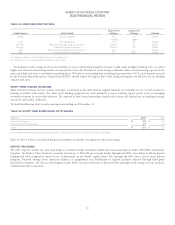American Express 2014 Annual Report Download - page 41
Download and view the complete annual report
Please find page 41 of the 2014 American Express annual report below. You can navigate through the pages in the report by either clicking on the pages listed below, or by using the keyword search tool below to find specific information within the annual report.
AMERICAN EXPRESS COMPANY
2014 FINANCIAL REVIEW
Common Equity Tier 1 Risk-Based Capital Ratio — The Common Equity Tier 1 risk-based capital ratio is calculated as Common Equity Tier
1 capital, divided by risk-weighted assets. Common Equity Tier 1 is the sum of common shareholders’ equity, adjusted for ineligible goodwill
and intangible assets, certain deferred tax assets, as well as certain other comprehensive income items as follows: net unrealized gains/losses
on securities and derivatives, and net unrealized pension and other postretirement benefit losses, all net of tax and subject to transition
provision. Common Equity Tier 1 capital as of December 31, 2014 was $17.5 billion.
Tier 1 Risk-Based Capital Ratio — The Tier 1 capital ratio is calculated as Tier 1 capital divided by risk-weighted assets. Tier 1 capital is the
sum of Common Equity Tier 1 capital, our perpetual preferred stock and third-party non-controlling interests in consolidated subsidiaries.
Tier 1 capital as of December 31, 2014 was $18.2 billion.
Total Risk-Based Capital Ratio — The total risk-based capital ratio is calculated as the sum of Tier 1 capital and Tier 2 capital, divided by
risk-weighted assets. Tier 2 capital is the sum of the allowance for receivable and loan losses (limited to 1.25 percent of risk-weighted assets) a
portion of the unrealized gains on equity securities, $600 million of subordinated notes issued in the fourth quarter of 2014 and a $750
million subordinated hybrid security. The $750 million subordinated hybrid security does not meet the requirements of Tier 2 capital under
Basel III, and is being transitioned out of capital (the total amount included in Tier 2 capital as of December 31, 2014 was $375 million).
Hence, the total amount of subordinated debt included in Tier 2 capital as of December 31, 2014 was $975 million. Tier 2 capital as of
December 31, 2014 was $2.6 billion. See “Fully Phased-in Basel III” section.
Tier 1 Leverage Ratio — The Tier 1 leverage ratio is calculated by dividing Tier 1 capital by our average total consolidated assets for the most
recent quarter. Average total consolidated assets as of December 31, 2014 were $154.7 billion.
The following provides a definition for Tangible Common Equity to Risk-Weighted Assets ratio, which is widely used in the marketplace,
although it may be calculated differently by different companies:
Common Equity and Tangible Common Equity to Risk-Weighted Assets Ratios — Common equity equals our shareholders’ equity of $20.7
billion as of December 31, 2014, less preferred shares of $0.7 billion. Tangible common equity, a non-GAAP measure, equals common equity
less goodwill and other intangibles of $3.9 billion as of December 31, 2014. We believe presenting the ratio of tangible common equity to
risk-weighted assets is a useful measure of evaluating the strength of our capital position.
FULLY PHASED-IN BASEL III
Basel III, when fully phased-in, will require bank holding companies and their bank subsidiaries to maintain more capital than prior
requirements, with a greater emphasis on common equity. We estimate that had Basel III been fully phased-in during the twelve months
ended December 31, 2014, our reported Common Equity Tier 1 risk-based capital and Tier 1 risk-based capital ratios would have been 12.2
percent and 12.8 percent, respectively, and our reported Tier 1 leverage ratio would have been 11.1 percent. As of December 31, 2014, had the
Basel III rules been fully phased-in, our supplementary leverage ratio would be 9.4 percent.5These ratios are calculated using the
Standardized Approach for determining risk-weighted assets. As noted previously, we are currently taking steps toward Basel III Advanced
Approaches implementation in the U.S.
The Basel capital standards establish minimum requirements for the Tier 1 risk-based capital ratios that are 1.5 percent higher than the
minimum requirements for Common Equity Tier 1 risk-based capital ratios. This difference between Tier 1 capital, which includes common
equity and qualifying preferred securities, and Common Equity Tier 1 is also present in the minimum capital requirements within
Comprehensive Capital Analysis and Review (CCAR), beginning with the 2014 plan submissions. We received no-objection to issue
preferred stock in our 2014 CCAR submission. Accordingly, we issued $750 million of preferred shares in the fourth quarter of 2014. We also
anticipate a further issuance of preferred shares in the first quarter of 2015, subject to market conditions. The preferred shares issuance helps
to finance a portion of the Tier 1 capital requirements in excess of common equity requirements.
Our $750 million subordinated hybrid security, which was previously fully included in Tier 2 capital (but not in Tier 1 capital), does not
meet the requirements of Tier 2 capital under Basel III. The phase-out of this subordinated hybrid security from Tier 2 capital began in the
first quarter of 2014, which affects our total risk-based capital ratio. As previously mentioned, we issued $600 million of subordinated debt in
the fourth quarter of 2014, which qualifies as Tier 2 capital under Basel rules. Our total risk-based capital ratio is expected to remain well in
excess of the required minimum.
5The Fully Phased-in Basel III capital ratios are non-GAAP measures. We believe the presentation of the capital ratios is helpful to investors
by showing the impact of future regulatory capital standards on our capital ratios.
41
























